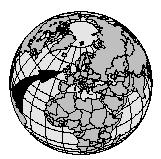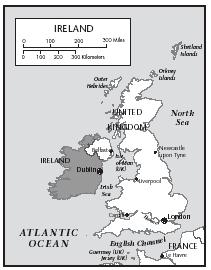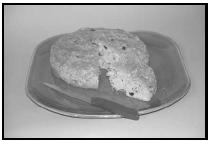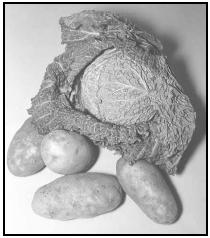Ireland
Recipes

1 GEOGRAPHIC SETTING AND ENVIRONMENT
Ireland, or officially the Republic of Ireland, is an island nation in the North Atlantic Ocean. (The northernmost part of the island is Northern Ireland, which is part of the United Kingdom.) Almost 20 percent of the land is devoted to farming. Less than 10 percent of farmland is used to grow crops and the majority is used as grazing land for livestock.
2 HISTORY AND FOOD
The arrival of the Anglo-Normans in Ireland in 1169 affected both farming and diet in Ireland. (Anglo-Normans are the Normans who remained in England after the Norman Conquest. Led by William the Conqueror, the Normans came from the Normandy region of France in 1066.) Wheat, peas, and beans became staple foods and people began preparing more elaborate dishes. Food customs were also changing, as French and Italian cooking customs influenced the upper-class cuisine.
The potato was introduced to Ireland by the late 1500s. Within 200 years it had replaced older staples, including oats and dairy products. The potato became the mainstay of the Irish diet. In the 1840s, the country's heavy reliance on potatoes led to the disaster known as the Irish Potato Famine. Most Irish farmers grew one particular variety of potato, which turned out to be highly sensitive to disease. A potato blight that had started in Belgium swept the country. It destroyed one-third of Ireland's potato crop in 1845 and triggered widespread famine. In the next two years, two-thirds of the crop was destroyed. More than one million people died as a result of the potato blight, and two million emigrated (moved away) to other countries. Even though they had suffered through the Irish Potato Famine (also called the Great Famine), Irish people continued to love potatoes. As soon as the spread of the disease

3 FOODS OF THE IRISH
Irish food is known for the quality and freshness of its ingredients. Most cooking is done without herbs or spices, except for salt and pepper. Foods are usually served without sauce or gravy.
The staples of the Irish diet have traditionally been potatoes, grains (especially oats), and dairy products. Potatoes still appear at most Irish meals, with potato scones, similar to biscuits or muffins, a specialty in the north. The Irish have also been accomplished cheesemakers for centuries. Ireland makes about fifty types of homemade "farmhouse" cheeses, which are considered delicacies.
Soups of all types, seafood, and meats also play important roles in the Irish diet. Irish soups are thick, hearty, and filling, with potatoes, seafood, and various meats being common ingredients. Since their country is surrounded by water, the Irish enjoy many types of seafood, including salmon, scallops, lobster, mussels, and oysters. However, meat is eaten more frequently at Irish meals. The most common meats are beef, lamb, and pork. A typical Irish dinner consists of potatoes (cooked whole), cabbage, and meat.
Irish stew has been recognized as the national dish for at least two centuries. A poem from the early 1800s praised Irish stew for satisfying the hunger of anyone who ate it:
Then hurrah for an Irish Stew
That will stick to your belly like glue.
Bread is an important part of Irish culture. Fresh soda bread, a crusty brown bread made from whole-wheat flour and buttermilk, is a national dish of Ireland. Irish bakers don't stop with soda bread, however. They bake a wide variety of other hearty breads and cakes.
The most common everyday beverage in Ireland is tea. Popular alcoholic beverages include whiskey, beer, and ale. Coffee mixed with whiskey and whipped cream is known throughout the world as "Irish coffee."
Traditional Irish Stew
Ingredients
- 4 potatoes, thinly sliced
- 4 medium onions, thinly sliced
- 6 carrots, sliced
- 1 pound Canadian bacon, chopped
- 3 pounds lamb chops, 1-inch thick, trimmed, and cut into small pieces
- Salt and pepper to taste
- 2½ cups water
- 4 potatoes, halved
- Fresh parsley, finely chopped
Procedure
- To make Irish stew, all the ingredients are assembled in layers in a large stew pot.
- Begin with layers of sliced potatoes, onions, and carrots.
- Top with a layer of Canadian bacon and lamb.
- Sprinkle liberally with salt and pepper.
- Repeat these steps until all the ingredients are used.
- Add enough water to just cover the ingredients.
- Arrange the halved potatoes on top of the stew, but not in contact with the water, so they can steam as the rest is cooking.
- Simmer over a very low heat for about 2 hours.
- Sprinkle liberally with the chopped parsley and serve in soup bowls.
Makes 4 to 6 servings.

Irish Soda Bread
Ingredients
- 4 cups flour
- 1 teaspoon baking soda
- 1 teaspoon salt
- ¾ cup raisins
- 2 Tablespoons caraway seeds
- 1 cup buttermilk
Procedure
- Preheat oven to 425°F.
- Mix flour, baking soda, and salt in a bowl. Add raisins and caraway seeds.
- Add buttermilk all at once and mix.
- Knead the dough on a lightly floured board. (To knead, press the dough flat, fold it in half, turn the dough, and repeat.) Form into a round loaf on a well-greased baking sheet.
- With a knife, carefully mark an X across the top of the loaf. Lay a piece of foil over the loaf. Bake for 5 minutes.
- Lower heat to 250°F and bake 30 minutes more. Remove foil and bake another 10 minutes, until the loaf is slightly browned.
- Cut into wedges and serve with butter.
Serves 10 to 12.
Corned Beef with Cabbage
Ingredients
- 4 pounds corned brisket of beef
- 3 large carrots, cut into large chunks
- 6 to 8 small onions
- 1 teaspoon dry mustard
- ¼ teaspoon thyme
- ¼ teaspoon parsley
- 1 head of cabbage (remove two layers of outer leaves)
- Salt and pepper
- Boiled potatoes as accompaniment
Procedure
- Place brisket in a large pot. Top with carrots, onions, mustard, thyme, and parsley.
- Cover with cold water, and heat until the water just begins to boil.
- Cover the pot with the lid, lower the heat, and simmer the mixture for 2 hours.
- Using a large knife, cut the cabbage into quarters, and add the cabbage wedges to the pot.
- Cook for another 1 to 2 hours or until the meat and vegetables are soft and tender.
- Remove the vegetables to a platter or bowl, cover with foil, and keep them warm.
- Remove the brisket, place it on a cutting board, and slice it.
- Serve the corned beef slices on a platter, surrounded by the vegetables.
- Ladle a little of the cooking liquid over the meat and vegetables.
Serves 12 to 16.
Champ
This is one of the most widely eaten potato dishes in Ireland.
Ingredients
- 6 to 8 baking potatoes, unpeeled
- 1 bunch scallions
- 1½ cups milk
- 4 to 8 Tablespoons butter (to taste)
- Salt and pepper
Procedure
- Scrub potatoes (do not peel), place them in a pot, and cover them with water.
- Heat the water to boiling, and cook the potatoes until they can be pierced with a fork (about 25 minutes).
- Finely chop the scallions (use both the white bulbs and the green stems) and put them in a small saucepan.
- Cover the scallions with the milk and bring slowly just to a boil.
- Simmer for about 3 to 4 minutes, stirring constantly with a wooden spoon. Turn off the heat and let the mixture stand.
- Peel and mash the hot boiled potatoes in a saucepan. Add the milk and scallions mixture and beat well.
- Beat in the butter. Season to taste with salt and pepper.
- Serve in 1 large or 4 individual bowls with a pat of butter melting in the center of each serving. May be reheated.
Serves 4 to 6.
4 FOOD FOR RELIGIOUS AND HOLIDAY CELEBRATIONS
The most festive holiday meal of the year is Christmas dinner, followed by Easter Sunday dinner. During the 40 days of Lent, Irish Catholics choose certain foods they wish to not eat. At one time, all animal products, including milk, butter, and eggs, were not to be consumed during Lent. The poorer Catholics of Ireland were often left to eat only oatcakes for the 40-day period. On Good Friday, the Friday before Easter Sunday, the Irish eat hot cross buns, a light, bread-like pastry topped with a frosting cross that holds spiritual meaning.
Another day on the Catholic calendar that the Irish Catholics do not eat meat is All Saints' Day (November 1). Each county has its own special meatless dishes for this occasion. Popular dishes include oatcakes, pancakes, potato pudding, apple cake, and blackberry pies. For Christmas, people throughout Ireland eat spiced beef, and a fancy Christmas cake full of dried and candied fruits for dessert.
All Saints' Day Dinner
- Nettle soup
- Colcannon
- Poached plaice fillets
- Soda bread
- Barm Brack
- Carrot pudding
Christmas Dinner
- Kidney soup
- Christmas goose (roasted) with chestnut stuffing and port sauce
- Garden peas with fresh mint
- Potato oat cakes
- Christmas cake
- Mince pies

Colcannon
This potato and cabbage dish is traditionally served on Halloween with a ring or lucky charm hidden in the center.
Ingredients
- 1 pound kale (or green leafy cabbage)
- 1 pound potatoes
- 6 scallions (or small bunch of chives)
- ⅔ cup milk (or half-and-half)
- Salt and freshly ground black pepper
- 4 to 8 Tablespoons butter, melted
Procedure
- Remove the tough stalk from the kale or cabbage and shred the leaves finely.
- Put about 1 inch of water in a saucepan large enough to hold the kale, and add a teaspoon of salt.
- Heat the salted water until it boils, and add the kale. Cook, covered for 10 to 20 minutes until the kale is very tender. Drain well.
- Scrub the potatoes and place them in a saucepan, unpeeled. Add water to cover.
- Heat the water to boiling, and cook the potatoes until tender (about 25 minutes).
- Drain, peel, and return to the pan over low heat to evaporate any moisture (This will take just a minute or so).
- Mash the potatoes while warm until they are smooth.
- Chop scallions and simmer in the milk or cream for about 5 minutes.
- Gradually add this liquid to the potatoes, beating well to give a soft, fluffy texture.
- Beat in the kale or cabbage along with the salt and pepper.
- Heat thoroughly over low heat and serve in bowls. Make an indentation in the center and pour in some melted butter.
Barm Brack
Barm Brack is the traditional cake bread eaten at Halloween.
Ingredients
- 6 cups flour
- ½ teaspoon allspice
- 1 teaspoon salt
- 1 envelope active dry yeast
- 4 Tablespoons sugar
- 1¼ cups warm milk
- ⅔ cup warm water
- 4 Tablespoons butter, softened
- 4 Tablespoons currants
- 5 Tablespoons orange or lemon peel, chopped
- Milk or syrup, to glaze
- Powdered sugar, to decorate
Procedure
- The night before baking, make a cup of tea, and put the currants and chopped peel into it to soak overnight.
- Mix the flour, allspice, and salt together. Stir in the yeast and sugar.
- Make a well in the center of the flour mixture, and pour in the milk and water, and mix into a dough.
- Move dough to a floured board and knead for 5 or 6 minutes, adding flour as necessary, until smooth and no longer sticky. (To knead, flatten the dough slightly, fold it over, flatten again, turn.)
- Place dough in a clean bowl, cover with plastic wrap, and leave in a warm place for 1 hour to rise (expand) to about double in size.
- Turn the dough back out onto the floured board, and add the butter, currants, and chopped peel and knead into the dough.
- Return the dough to the bowl and cover again with plastic wrap. Leave to rise for another 30 minutes.
- Grease a 9-inch round cake pan. Fit the dough into pan, cover with plastic wrap, and leave until the dough rises to the edge of the tin (about 30 minutes).
- Preheat oven to 400°F.
- Brush the surface of the dough with milk and bake for 15 minutes.
- Cover loosely with foil; reduce the heat to 350°F and bake for 45 minutes more.
- Sprinkle with powdered sugar.
Serves 12.
Irish Christmas Cake
The cake tastes best when baked 1–3 weeks ahead of time. This traditional cake is served at holiday festivities throughout December. It is traditionally decorated with marzipan (almond paste), white icing, and holly sprigs.
Ingredients
- 2¼ cups dried currants
- 2 cups golden raisins
- 1 cup dark raisins
- ¼ cup candied cherries
- ¼ cup candied fruit peel
- ⅔ cup almonds, chopped
- 1 lemon (juice and grated rind of its peel)
- 1½ teaspoons allspice
- ½ teaspoon nutmeg, ground
- 1 cup Irish whiskey (used in ½-cup amounts; may substitute ½-cup strong tea)
- 2 sticks butter, room temperature
- 1 cup firmly-packed light brown sugar
- 5 eggs
- 2 cups flour
- Marzipan (almond paste)
- White icing (purchased)
- Holly sprigs (optional decoration)
Procedure
- The day before baking: Combine all the fruit, peel, rind and juice, spices, and nuts in a large bowl with ½ cup of the whiskey (or tea) and let soak overnight.
- The day of baking: Preheat oven to 275°F and grease a 9-inch round cake pan, lining the bottom with cooking parchment paper.
- In a large bowl, cream the butter and sugar together until light and fluffy.
- Beat the eggs in one at a time, adding flour with each egg.
- Mix in the remaining flour and soaked fruit.
- Pour the mixture into the cake pan and bake until it is firm to the touch and a toothpick inserted into the center comes out clean, about 2 hours.
- Let the cake cool in the pan for 30 minutes. If substituting tea for whiskey, skip this step: Prick the top in several places and pour the remaining ½ cup whiskey over the top.
- Wrap in plastic wrap, then foil, and store in a cool, dark place for several weeks to allow the cake to mature (fully absorb the flavors). The cake can be unwrapped occasionally and more whiskey added, if desired.
5 MEALTIME CUSTOMS
The Irish value hospitality, and generous portions of food are common at home and in restaurants.
A large breakfast was traditionally eaten in rural Ireland. Common breakfast foods included soda bread, pancakes, porridge, eggs, and various meat products. A full oldfashioned country breakfast might include fresh fruit juice, porridge, a "mixed grill" of breakfast meats and black pudding, scones, and soda bread with butter and preserves, tea, and coffee with hot milk.
Dinner, the main meal of the day, used to be eaten at lunchtime. A typical dish was "Dublin coddle," a bacon, sausage, potato, and onion soup. Today, however, many Irish people eat lighter meals in the morning and at midday. They have their main meal later in the day, when they come home from work or school. Lunch is often a bowl of hot soup that is served with freshly baked soda bread. However, many pubs (bars) still serve the traditional large midday dinner. "Supper" in Ireland means a late-night snack. A typical supper is a slice of bread with butter and a glass of milk.
Dublin Coddle
Ingredients
- 1 pound bacon, sliced
- 2 pounds pork sausage links
- 2 onions, peeled and sliced
- 2 cloves garlic, whole
- 4 large potatoes, thickly sliced
- 2 carrots, thickly sliced
- 1 bouquet garni (bay leaf, tarragon, whole cloves, whole peppercorns; see Procedure step 8)
- Black pepper
- Apple cider (about 4 cups)
- Chopped parsley for garnish
Procedure
- Separate bacon into slices and place them side by side in a large frying pan. (The bacon may be cooked in batches.) Fry over low heat, turning once, until crisp. Drain bacon grease from pan before cooking another batch.
- Drain the pan and wipe most of the bacon grease out with a paper towel.
- Place sausages in the pan to brown (again, the sausage may be browned in batches).
- Place bacon and sausages in a large pot.
- Drain frying pan again, wipe it with a paper towel, and add the sliced onions and garlic cloves, cooking them over low heat until the onions are softened.
- Add onions and garlic to the bacon and sausage in the pot.
- Add the thick slices of potato and carrot.
- Make a bouquet garni: In a 3-inch square of cheesecloth, place 1 bay leaf, ½ teaspoon tarragon, 2 whole cloves, and 2 whole peppercorns. Tie with twine, and place in pot.
- Cover everything with apple cider (or apple juice).
- Cover, and simmer 1½ hours over medium-low heat. The soup should not boil.
- Serve, garnished with a sprinkling of parsley and black pepper.
Serves 8 to 10.
The Irish are known for their rich, dark beer, called stout. The most famous and widely known brand is called Guinness. Tea is another popular beverage. It is served with scones, probably the most popular snack in Ireland. "Fish and chips," or battered and fried fish served with French fries, is also very popular.
Scones
Ingredients
- 8 cups flour
- Pinch of salt
- ⅓ cup sugar
- 4 teaspoons baking powder
- 1½ sticks butter (¾ cup)
- 3 eggs
- 1¾ cups milk
Procedure
- Preheat oven to 475°F.
- Combine flour, salt, sugar, and baking powder in medium mixing bowl.
- Cut butter into small cubes and add it to the flour mixture. With clean fingertips, rub the butter into the flour.
- In a separate bowl, beat the eggs and milk together. Add to the flour-butter mixture to make a soft dough.
- Place mixture on a floured board. Knead lightly for 3 or 4 minutes.
- Roll out with a rolling pin to a thickness of about one inch.
- Cut dough into 3-inch circles, using a cookie or biscuit cutter.
- Place dough circles onto a lightly greased cookie sheet. Bake 10 to 12 minutes until golden brown.
- Cool on a wire rack.
- Serve, split in half, with berry jam.
Makes 18 to 20 scones.
Apple Cake
Ingredients
- 1 pound of apples (about 3 or 4 medium)
- Juice and grated rind of 1 lemon
- ¾ cup butter (1½ sticks)
- 1 cup sugar
- 3 eggs, beaten
- 2 cups self-rising flour
- ½ teaspoon baking powder
- ½ teaspoon cinnamon, ground
- 5 Tablespoons raisins
- 2 Tablespoons hazelnuts, chopped
- 4 Tablespoons powdered sugar
Procedure
- Preheat oven to 350°F and grease a 9-inch round cake pan.
- Peel, core, and slice the cooking apples and place them in a bowl.
- Sprinkle apples with the lemon juice and set aside.
- In another bowl, beat together the butter, lemon rind, and all but 1 Tablespoon of the sugar until light and fluffy.
- Gradually beat in the eggs.
- Add the flour and baking powder to the butter mixture and mix well.
- Spoon half of the mixture into the prepared cake tin. Arrange the apple slices on top.
- Mix the remaining Tablespoon of sugar and the cinnamon together in small bowl. Sprinkle evenly over the apples.
- Scatter the raisins and hazelnuts on top.
- Smooth the remaining cake mixture over the raisins and hazelnuts.
- Bake for 1 hour.
- Cool in the tin for 15 minutes. Remove, transfer to a serving platter, and sprinkle with powdered sugar.
Serves 12.
6 POLITICS, ECONOMICS, AND NUTRITION
Modern Ireland has few problems related to availability of food. In the early part of 2001, Irish cattle and sheep farmers, like other farmers in Europe, were fighting against an outbreak of hoof and mouth disease, a deadly viral disease that is fatal to hoofed animals. By summer, the outbreak had been brought under control.
Irish citizens generally receive adequate nutrition in their diets, and Irish children are considered healthy by international health care agencies.
7 FURTHER STUDY
Books
Albyn, Carole Lisa, and Lois Webb. The Multicultural Cookbook for Students. Phoenix: Oryx Press, 1993.
Allen, Darina. The Complete Book of Irish Country Cooking: Traditional and Wholesome Recipes from Ireland. New York: Penguin, 1995.
Connery, Clare. In An Irish Country Kitchen. New York: Simon and Schuster, 1992.
Drennan, Matthew. Irish: The Taste of Ireland in Traditional Home Cooking. London: Lorenz Books, 1999.
Halvorsen, Francine. Eating Around the World in Your Neighborhood. New York: John Wiley & Sons, 1998.
Johnson, Margaret M. The Irish Heritage Cookbook. San Francisco: Chronicle Books, 1999.
Web Sites
GoIreland.com. [Online] Available http://www.goireland.com/ireland/soda_bread.htm (accessed August 7, 2001).
Ireland, The Food Island. [Online] Available http://www.foodisland.com (accessed July 9, 2001).